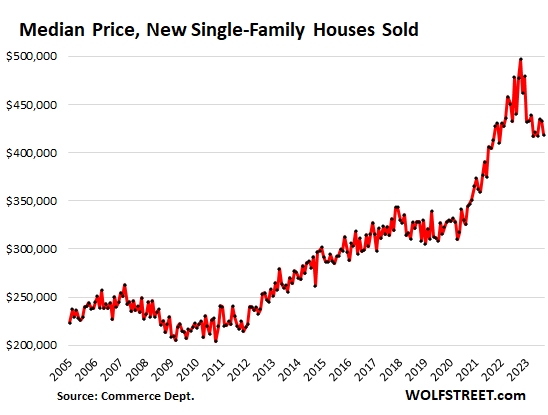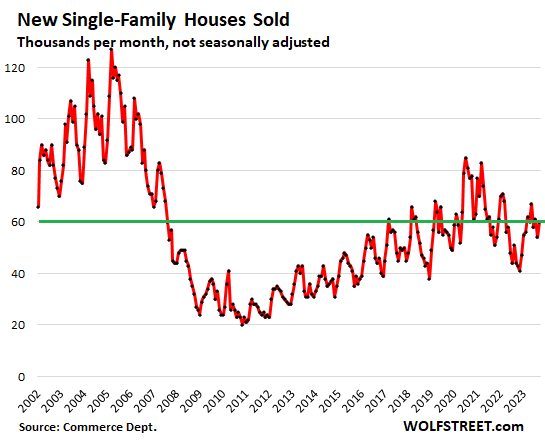by Wolf Richter, Wolf Street:
 What homebuilder PulteGroup said about mortgage-rate buydowns. Homebuilders have figured out this market, homeowners have not.
What homebuilder PulteGroup said about mortgage-rate buydowns. Homebuilders have figured out this market, homeowners have not.
To sell new houses in this 8%-mortgage environment, homebuilders – whose stocks have gotten battered since August – have resorted to mortgage-rate buydowns through their own mortgage companies. Earnings calls are now all about those buydowns and their costs, including PulteGroup’s earnings call yesterday which is currently buying down 30-year 8% fixed-rate mortgages permanently to 5.75%.
TRUTH LIVES on at https://sgtreport.tv/
That incentive works in selling houses; but costs are steep. We’ll get to the earnings call in a moment, but keep that in mind as we walk through the figures on new house sales, prices, and inventories.
The median price of new single-family houses sold in September fell by 3.3% from the prior month, and was down by 12.3% from a year ago, and down by 15.7% from the peak in October 2022, according to data from the Census Bureau today. As you can see in the chart, following a big drop, it has essentially moved sideways since April.

But these are contract prices and do not include the costs of mortgage-rate buydowns and other incentives such as upgrades of countertops.
In this regard, Pulte said that its “incentive load” – now mostly mortgage rate buydowns – was 6.3% of the average selling price of $549,000 in Q3, or $35,000 per house. These buydowns effectively lower the buyer’s costs, but they’re not included in the data here by the Census Bureau, which tracks contract prices.
Sales of new houses – not seasonally adjusted, and not the annual rate of sales – rose to 60,000 houses in September, up by 36% from the beaten-down levels a year ago. These sales levels would normally be nothing to write home about, but in the 8% environment, they’re pretty good, testimony to the effectiveness of price cuts, houses built at lower price points, and mortgage-rate buydowns.

Homebuilders, unlike current homeowners, have figured out this market. Their business is to build and sell homes no matter what the market does. But homeowners who want to sell are still muttering, “this too shall pass,” and are not putting their homes on the market, and those that are putting them on the market are now cutting prices at a substantial rate but not nearly enough to bring in buyers, so sales of previously owned homes have plunged.
Inventory for sale of new houses in all stages of construction rose to 441,000 houses. And supply, given the increase in sales, dipped to a still fairly high 6.9 months. This would have been the highest supply in the years between 2011 and March 2020, so more than ample inventory and supply, and homebuilders will have to move it, and they’ll be motivated to play with prices and incentives:



